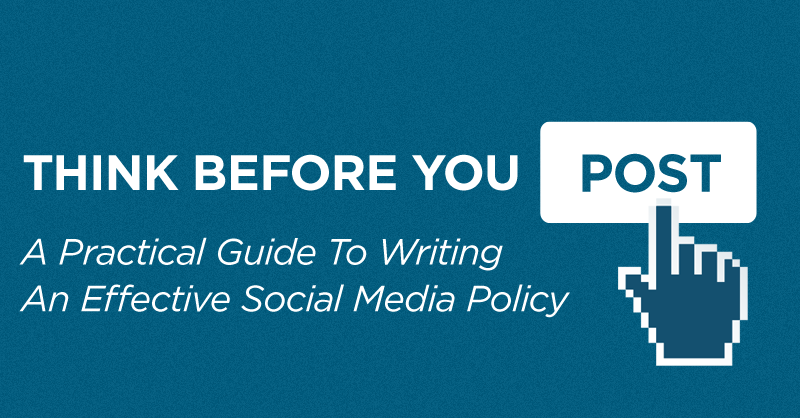
For many organizations social media is a double edged sword. On the one hand, it can help spread good-will about an organization in an organic and genuine way.
However, the same characteristics that enable social media to benefit a company make it capable of destroying reputations if used incorrectly. To help encourage positive use of social media, while carefully mitigating any potential for risk, companies are finding it increasingly necessary to outline clear social media policies.
In much the same way that a mission statement provides overall direction for a company’s strategic decisions, and a style guide directs the way that your brand is presented visually to the public; a social media policy establishes a set of guidelines that govern how various company stakeholders represent your brand on various social networks.
This article will outline some practical considerations to have in mind when writing a social media policy for your organization.
1. Incorporate Your Company Culture
Before you start hammering out the technicalities of your company’s policy it is important to understand that the goal of any social guidelines should be to reinforce and reflect the unique values, culture and ideals of your organization.
Prior to telling your employees how to be effective brand ambassadors online, it is necessary to have a strong understanding of the qualities you want them to exemplify as well as the unique attitudes of those employees.
For example, IBM understands that the type of employees they attract are people who are passionate about ideas and naturally want to share this information. Although such public sharing of private company knowledge can be risky, IBM realizes that banning such activity outright would stifle the potential good it might produce and go against the nature of their employees.
One sentence from IBM’s social policy stands out in particular:
“Through these [online] interactions, IBM’s greatest asset—the expertise of its employees—can be shared with clients, shareholders, and the communities in which it operates.”
In one concise statement, IBM both establishes its position as an organization that values its employees’ ideas and encourages their inclination to share these ideas. The tone of the rest of the document follows from this idea. The reader can sense that IBM trusts their judgement, and simply wants to encourage their employees to share online while exercising proper judgement.
Try following IBM’s lead by paying close attention to your organization’s unique culture before attempting to create guidelines that your employees will be forced to follow.
2. Don’t Underestimate the Value of Common Sense
You wouldn’t have hired an employee if you didn’t believe they had good judgment, so it only makes sense to assume that if you ask your employees to exercise common sense online they will comply. The sheer variety of interactions that occur online all but guarantee that you won’t be able to anticipate and highlight all the things employees should avoid talking about online.
Certainly make sure to make specific note of the kinds of sharing that are explicitly forbidden (like proprietary company information, swearing, etc…), but also understand that simply asking your employees to use common sense before posting online can prevent a lot of missteps.
This is especially true if you followed the first piece of advice and made the values your organization hopes to express online clear. Make clear what is expected of employees who choose to participate in social media. You can clarify even further by providing some templates or examples of good posts that they can refer back to in the future.
By giving your employees enough latitude to trust their own instincts and communicating that you trust and rely on their good judgment, they will not feel like they are being forced to do anything and will instead feel personally responsible to represent the company sensibly.
Coca-Cola puts this advice in a very succinct and effective way; “When in doubt, do not post.”
3. Don’t Discourage Social Media Use
This might seem really obvious, but a lot of social media policies are written in such a way that they actually come off discouraging social media use. While policy might dictate that certain uses of social media are off limits, make sure to cut down on the amount of negative language and restrictions.
If employees feel that using social media might threaten their job, they will certainly not use it and also might end up resenting your organization. There is even a slang term for losing your job due to social media missteps.
The thing is that, when used correctly, social media can contribute a lot of value to your organization. As mentioned before, IBM understands the value that social media can add to their organization, and wrote their policy in such a way that clearly lays out the rules without being intimidating or overbearing.
By communicating that you trust your employee’s good judgment and not being overly prohibitive you can not just prevent poor use of social media, but encourage its productive use.
4. Communicate Simply and Memorably
Although your social media policy must comply with various employment laws and clearly state what types of online communications are acceptable, try and avoid the stiff, stunted legalese that often plagues corporate communication.
Your social media policy, however well thought out, is useless if it is not readable and succinct. Keep your writing conversational and have your audience in mind. After all, they will probably only read it once but will have to follow it for their entire time with your organization.
Take the lead from Wal-Mart, whose policy has a conversational yet authoritative tone, that makes it memorable and easy to read. The document has to appeal to a variety of stakeholders of varying formality and the author clearly took the time to write the policy in such a way that it worked for an associate or an executive level employee.
Making your social media policy easy to read will ensure that your employees react positively to the policy and will increase the likelihood that they remember and follow the guidelines you establish.
Final Thoughts:
It’s worth pointing out that all the guidelines mentioned above have a central theme in common. They all require that the social media policy’s author does not just rattle off a set of dos and don’ts, but rather considers his or her employees and organization carefully.
The most effective policies are not those that impose the most restrictions or have the most fine print; rather, they are the rules that fit the existing culture so well, are articulated so clearly, and are made so self-evident that employees follow the rules without even realizing thinking twice.
Do you already have a social policy? If you do, does it follow all or some of these guidelines? Are there any considerations you think I missed? Let me know in the comments below. And as always, thanks for reading.


